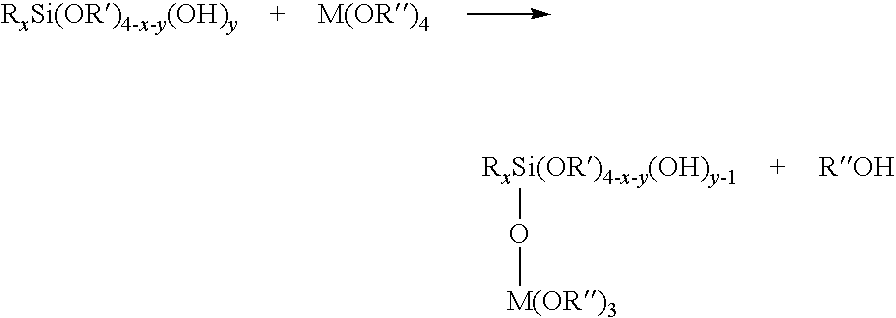Tintable film-forming compositions having high refractive indices and coated optical articles using same
a technology of high refractive index and composition, applied in the direction of instruments, transportation and packaging, synthetic resin layered products, etc., can solve the problems of difficult incorporation of colorants or tints into certain abrasion resistant coatings, blotchy appearance, and surface that is susceptible to abrasion and chemical attack
- Summary
- Abstract
- Description
- Claims
- Application Information
AI Technical Summary
Problems solved by technology
Method used
Image
Examples
example 1
[0074]γ-Glycidoxypropyltrimethoxysilane, 775 grams, and a dilute solution of nitric acid, 77.5 grams, prepared by adding 1.0 gram of 70 weight percent nitric acid to 7 L of deionized water, were added to a clean, dry 5 L reactor with stirring. Within fifteen minutes, the exotherm generated from the hydrolysis of the silanes caused an increase in the temperature of the reaction mixture from 20° C. to 35° C. A 50 / 50 weight ratio of DOWANOL® PM and PMA solvents, 744 grams, was added to the mixture with stirring and the temperature of the reaction mixture was lowered to 15° C. with an ice bath. Titanium n-butoxide (693 grams) was added and the resulting exotherm caused an increase in the temperature of the reaction mixture within 15 minutes to 30° C. The temperature of the reaction mixture was lowered to 15° C. with an ice bath. Cerium oxide, 704 grams of a 20 weight percent aqueous solution was added and the resulting exotherm caused an increase in the temperature of the reaction mixtu...
example 2
Part A
[0076]Finished 6-base piano lenses identified as MR-20 lenses (available from That Optical Group) were soaked in a 12.5 weight percent sodium hydroxide solution in an ultrasonic bath maintained at 50° C. for 5 minutes; rinsed in an ultrasonic bath containing deionized water maintained at 50° C.; rinsed with isopropyl alcohol; and dried at ambient temperature.
Part B
[0077]The coating solutions of Example 1 and Comparative Examples 1 and 2 were warmed to room temperature (about 20-24° C.) with stirring, if necessary, and applied to the lenses prepared in Part A by dipcoating. The withdrawal rate used was 15 centimeters per minute. Afterwards, the lenses were dried and cured in an air circulating oven for 20 minutes at 60° C. followed by 3 hours at 105° C.
Part C
[0078]Abrasion resistance of the lenses prepared in Part B was determined using ASTM F735-81 Standard Test Method for Abrasion Resistance of Transparent Plastics and Coatings Using the Oscillating Sand Method. The test samp...
PUM
| Property | Measurement | Unit |
|---|---|---|
| refractive index | aaaaa | aaaaa |
| refractive index | aaaaa | aaaaa |
| Haze Gard Plus Instrument | aaaaa | aaaaa |
Abstract
Description
Claims
Application Information
 Login to View More
Login to View More - R&D
- Intellectual Property
- Life Sciences
- Materials
- Tech Scout
- Unparalleled Data Quality
- Higher Quality Content
- 60% Fewer Hallucinations
Browse by: Latest US Patents, China's latest patents, Technical Efficacy Thesaurus, Application Domain, Technology Topic, Popular Technical Reports.
© 2025 PatSnap. All rights reserved.Legal|Privacy policy|Modern Slavery Act Transparency Statement|Sitemap|About US| Contact US: help@patsnap.com


